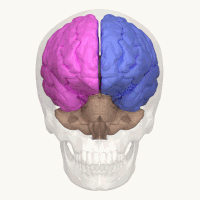
Photo from wikipedia
Is life an inkblot, or is life a neuropsychological test? A corollary would be which is more predictive of life outcomes, the assessment of psychological phenomenon, the mind, or neurocognitive… Click to show full abstract
Is life an inkblot, or is life a neuropsychological test? A corollary would be which is more predictive of life outcomes, the assessment of psychological phenomenon, the mind, or neurocognitive abilities, the brain? As a clinical psychologist trained in the metaphysics of psychiatry and psychology, which defines our area of interest as the space between the mind and brain (Weisman, 1987), I find this question impossible to answer. I was taught that the mind and brain are colocated, share a psychophysical developmental process, and exert bidirectional causation (interactionism; see Popper & Eccles, 1977). More important, I believe that patients bring both mind and brain to a psychological evaluation. From this understanding, I conceptualize psychological assessment as a method for exploring how mind–brain interactions affect functioning and psychological well-being, albeit one patient at a time. Broad, multifaceted constructs like impulsivity fit nicely into my conceptualization of assessment. The study of impulsivity spans several subdisciplines. It can be studied as a neurobehavioral system, personality trait, symptom of psychopathology, or neuropsychological capacity. Impulsivity and other transdisciplinary constructs illustrate the value of multimethod assessment and the benefit of integrating cross-method data. Although more focused on technical psychometrics, the target article (Samiefard et al., this issue) clearly showed the power of multi-instrument, multimethod assessment. The results showed that a combination of psychopathology, personality, and neuropsychology scales achieved the most robust assessment (prediction) of impulsivity facets. This is essentially the foundation of clinical assessment. The commonalities in multisource data converge (somewhat), allowing for more confident identification of a trait. In contrast, unique aspects of these data provide a richer understanding (description) of how impulsivity affects the patient’s life. Multisource data allow us to decompose impulsivity and other multifaceted constructs into their fundamental affective, behavioral, and cognitive dimensions, aiding behavioral prediction. Identifying that a patient is impulsive is clinically helpful, but describing the circumstances likely to lead to impulsive behavior provides more utility. At a more general level, the findings of Samiefard et al. are consistent with the widely accepted view that most forms of psychopathology have associated neurocognitive deficits. Furthermore, although no unique neurocognitive signatures have emerged, attention, memory, and executive function disruptions have consistently been found in psychiatric samples (East-Richard et al., 2020). Deficits in these neurocognitive domains can significantly affect treatment adherence, outcome, and daily functioning. In this study, digit span, a simple cognitive test familiar to most clinical psychologists, meaningfully improved the assessment of impulsivity. Sophisticated neuropsychological tests are not required to extend an assessment battery to cover the mind and brain. I have found it beneficial to include a few simple neurocognitive measures in my standard assessment battery and have taught this approach for many years. To be clear, I am not suggesting that we act as neuropsychologists, as neuropsychology is a specialty practice requiring extensive proscribed training. Instead, if we believe that psyche and soma are interrelated, assessing a few broad neurocognitive dimensions, like processing speed and cognitive flexibility (see Carroll, 1993), is logical and will benefit our patients and psychological assessment in general. Papers from our Massachusetts General Hospital Psychological Evaluation and Research Laboratory have demonstrated how neurocognitive measures can be integrated into routine clinical assessment and the additional insights they can provide (see Blais & Bello, 2014). Emerging dimensional models of psychopathology and personality will make such integration more intuitive and powerful. Psychometric articles like that of Samiefard et al. offer other benefits to practitioners if we are open to them. For example, although many broadband tests measure impulsivity, as practitioners, we might not be familiar with facets of the construct or advances in impulsivity theory. Reviewing the rationale (theory) underlying narrow-band tests, like the short form of the UPPS-P scale (S-UPPS-P), can highlight limitations in our standard instruments and our knowledge
Journal Title: Journal of Personality Assessment
Year Published: 2023
Link to full text (if available)
Share on Social Media: Sign Up to like & get
recommendations!